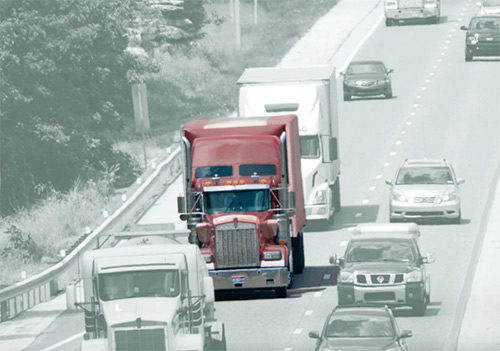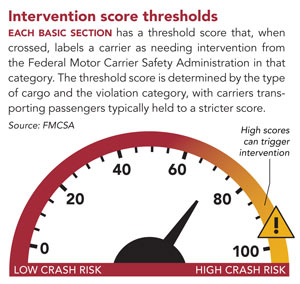An accurate score?
Carrier safety rating system methods under debate

KEY POINTS
- Violations made by individual drivers – including non-safety-related violations – count against the carrier's rating. However, in response to complaints, FMCSA now weights violations such as not paying a parking ticket lower than violations such as speeding or falsifying logs.
- FMCSA is conducting research to determine whether carriers' ratings should be affected by crashes that were not the driver's fault.
- Carriers are graded on a curve againts other carriers with similar characteristics, and some organizations are questioning whether some unsafe carriers will go undetected if all carriers in a particular category are unsafe.
With limited time and resources, the Federal Motor Carrier Safety Administration is focusing its intervention efforts on the commercial motor carriers that pose the greatest risk to safety on U.S. roadways. At issue: What is the best way to determine which carriers have the greatest future crash risk and are most in need of intervention?
In an effort to identify at-risk carriers, FMCSA launched the Compliance, Safety, Accountability program in December 2010 as a replacement for the agency’s SafeStat system. CSA’s Safety Measurement System assigns carriers scores in areas known as Behavior Analysis and Safety Improvement Categories, based on violation data FMCSA receives about the carrier. When a carrier exceeds an intervention threshold for a particular BASIC, the agency may begin to take action, such as sending warning letters and conducting investigations.
Since March 2012, CSA’s methodology has been the subject of Federal Register comments from more than 14,000 carriers and 1,700 law enforcement personnel, as well as truck driver associations and safety advocates.
According to FMCSA, the new system works: From 2010 to 2011, CMV violations per roadside inspection declined 8 percent and driver violations per inspection declined by 10 percent under the new system – the most significant reduction in violation rates in 10 years.
The agency also cites research from the University of Michigan Transportation Research Institute showing that carriers currently listed in the system as having above-threshold levels of violations related to unsafe or fatigued driving have 3 times more crashes than other carriers.
A study released online Oct. 1 by the American Transportation Research Institute, the research arm of the Arlington, VA-based American Trucking Associations, found a “strong” relationship between unsafe or fatigued driving violations and crash risk, as well as a similar relationship for vehicle maintenance violations. However, ATRI claims violations in two other SMS categories – “Controlled Substances/Alcohol” and “Driver Fitness” – were found to be inversely related to crash risk.
ATA has accused CSA of determining “patterns of violations” rather than the carrier’s future crash risk.
“ATA supports CSA’s original goal of reducing crashes by targeting unsafe carriers, but too often, the system highlights violations that bear little direct – or even indirect – relationship to crash risk,” Bill Graves, ATA president and CEO, said in an August press release. “FMCSA must continue to hold true to CSA’s original goal and make changes to the program as necessary to do so.”
Scoring safety
Ruby McBride is vice president for corporate systems for Colonial Freight Systems Inc., a Knoxville, TN-based trucking company that has a crash ratio, including non-preventable crashes, of 0.4 crashes per million miles traveled – less than 28 percent of the level considered unsatisfactory.
However, when Safety+Health went to press, the company was listed in the CSA Safety Measurement System as exceeding the threshold for fatigued driving violations by more than 15 percent. McBride said this is due to receiving multiple “form and manner” violations, which are incurred when a driver incorrectly fills out a log by omitting information or adding numbers incorrectly in the “Fatigued Driving” category – something that doesn’t address safety or whether her company’s drivers will be in a future crash, she said.
“From our perspective, the current methodology unfairly labels a motor carrier as a high risk based upon a lot of data that has nothing to do with safety, such as form and manner violations and administrative errors,” she said.
In response to similar complaints submitted during the comment period, FMCSA announced in August that violations such as not paying a parking ticket will be weighted lower in severity than those for being caught speeding or falsifying logs.
Henry Jasny, vice president and general counsel for Washington-based Advocates for Highway and Auto Safety, said safety violations that affect a driver’s safety record should still count toward a carrier’s score, as they indicate poor safety management.
“The drivers are hired or given contracts by the companies,” he said. “Making management decisions about who your driver is going to be – is it a driver with a good record or a bad record – is a part of the safe management of your company. We want companies to be making those decisions so that the worst drivers are leaving the business and the best drivers are staying in.”
Determination of fault
FMCSA also received comments about how the system treats fault for a crash. At press time, any crash involving a company’s driver was recorded in the system – even if the driver was not responsible for the crash.
McBride said eliminating records of crashes that were not the fault of the driver from her company’s score would reduce the company’s crash ratio score by half. “We believe that there should not be points assessed against the motor carrier for accidents it is not responsible for, such as getting hit in the rear, or someone coming across the interstate to hit you, or being hit by a deer,” she said.
In a March 19 letter, ATA requested FMCSA use “common sense” by not holding carriers accountable for crashes that were clearly not the driver’s fault.
According to Jasny, however, research shows a link between crashes and future risk.
“This does not have to do with whether they’re at fault or the other driver is at fault,” he said. “The purpose behind this is that you can predict that a driver or a company that is involved in an unusually above-average number of crashes is going to be involved in crashes in the future,” he said.
In response to comments from both sides, FMCSA is researching how adding at-fault determinations into violation records in the system would affect a carrier’s rating.
Peer comparisons
 CSA’s SMS scores a carrier on a curve based on its rate of violations as compared to other carriers that share relevant characteristics. However, carriers that have not received a sufficient number of violations will not receive scores in the system. FMCSA stated in February that this approach allows the agency to prioritize its resources to focus on carriers that most need intervention.
CSA’s SMS scores a carrier on a curve based on its rate of violations as compared to other carriers that share relevant characteristics. However, carriers that have not received a sufficient number of violations will not receive scores in the system. FMCSA stated in February that this approach allows the agency to prioritize its resources to focus on carriers that most need intervention.
According to an ATA white paper released Oct. 16, FMCSA has stated that it has sufficient data to assess 40 percent of active U.S. carriers – about 200,000 – in at least one BASIC, and these carriers are involved in the majority of crashes directly reported to FMCSA. ATA disagrees. In the white paper, the association claims only about 12 percent of all active carriers have sufficient violation data to be assigned a peer comparison percentile ranking in the system for at least one category. This, ATA says, indicates a lack of data in the overall system, which affects small carriers especially strongly.
“A carrier is only as good as the next guy, and in order to succeed you must first fail – only fail less than everyone else in the same safety grouping,” Todd Spencer, executive vice president of Grain Valley, MO-based Owner-Operator Independent Drivers Association, said in comments submitted Sept. 13 to a House transportation subcommittee meeting on CSA.
“[If a company is] unsafe in a lot of their practices and they are getting violations for it, because they are not getting as many as the other 25 percent of 30 percent that are racking up more, they are going to fly under the radar,” he said.
The BASICs of CSA
- What is a “BASIC”? Click here to learn about the Behavior Analysis and Safety Improvement Categories included in the Compliance, Safety, Accountability program’s Safety Measurement System.
- Visit here for information about CSA and view the program’s SMS rating of carriers in the system by searching its name or Department of Transportation-assigned number.
- FMCSA recently executed multiple changes to how it determines a carrier’s future crash risk. Visit here for information on the new ratings, some of which were scheduled to go into effect this month.
Post a comment to this article
Safety+Health welcomes comments that promote respectful dialogue. Please stay on topic. Comments that contain personal attacks, profanity or abusive language – or those aggressively promoting products or services – will be removed. We reserve the right to determine which comments violate our comment policy. (Anonymous comments are welcome; merely skip the “name” field in the comment box. An email address is required but will not be included with your comment.)

